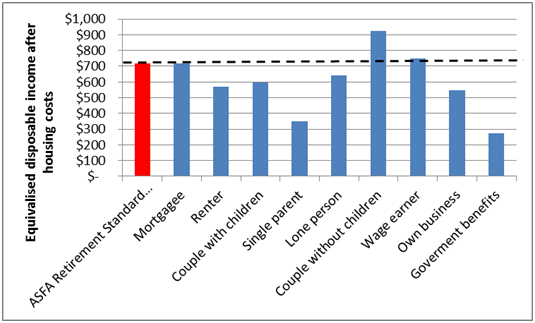
Find below an introductory post from our new blogger, The Householder, an economic specialist focused on households, labour force and wealth.
The old “how much money do I need to retire” is a favourite of financial planners. Usually they have a nifty calculator at hand that tells you how much you need based on the income you’re used to, whether you have a partner or a home, and what you’d like to do in retirement. If they can’t be bothered (or they’re a finance journalist looking for a headline figure), they might pull out the magic number: “You need $50 000 a year” or “you need half a million dollars to retire”, for example this or this.
These figures are (loosely) drawn from the ASFA Retirement Standard. This standard looks at what hypothetical single and couple households might want to consume in retirement, and figures out how much that consumption will cost. It estimates that for a ‘comfortable’ standard of living, with the family home owned outright, a single person will need an income of $41 186 per year (tax free, including a part age pension) or $56 339 if they are part of a couple. To get this sort of income in retirement, you will (based on their assumptions) need a lump sum of $430 000 ($510 000 for a couple).
If this figure has you gasping in horror and making voluntary contributions to your super lest you live on baked beans in your twilight years, it’s had the desired effect. Stop and think for a moment and compare this to your living standard now. How much money do you have left over each week after tax has been taken out of your pay, you’ve paid your rent/mortgage and paid for the kids’ expenses? If it’s less than $790 and you’re single, or $1080 total if you’re in a couple, then according to the ASFA Retirement Standard you don’t have a ‘comfortable’ standard of living.
And it’s not just you. Let’s tweak that retirement standard a little and remove ongoing housing costs – things like rates, water and repairs. The ASFA standard suggests that excluding housing, singles will need $719.45 per week or $37 411 per year to live ‘comfortably’.
How does this ‘comfortable’ standard compare to how people live while earning a wage? We can use household incomes from the 2009-10 Survey of Income and Housing, and inflate them to 2012-level earnings. We want to compare living standards in retirement to working age living standards. But working age households, unlike typical retired households, are often a) paying off a mortgage and b) raising kids, which means they need more money than retirees. How to fix for a) and b)?
Adjusting for a) housing costs is easy – the Survey calculates total weekly housing costs for each household, including rent or mortgage, body corporate, rates, water and so forth, so subtract that from after tax income. For b) kids, we divide incomes after tax and housing by an equivalising factor, which takes into account number of children and adults in a household, efficiencies in living together etc. and allows the living standards of different-size households to be compared. Then we end up with equivalised disposable incomes after housing for each household. These values allow us to compare living standards across households of different sizes, incomes and tenure, with the ASFA ‘comfortable’ retirement standard for a single person.
What this mouthful shows is that most people do not have a ‘comfortable’ living standard during their working lives (aged up to 55.) Of people who live in households with a reference person aged under 55, only 45% had an equivalised disposable incomes after housing of more than $719.45 per week, ASFA’s ‘comfortable’ standard ex housing. Fifty percent of homeowners with mortgages lived ‘comfortably’, compared with only 37 percent of renter households. Just over a third of couple households with children live ‘comfortably’ 43 percent of lone person households, 70 percent of couple only households, and less than 8 percent of single parent households. Even excluding households on government benefits, only 53 percent of wage earner households and 37 percent of households working in their own business lived ‘comfortably’ according to the ASFA standard.
The chart below compares the ASFA Retirement Standards for a single person, ex housing costs, with equivalised disposable household income after housing for selected households under 55.

Economists believe in income smoothing over the life cycle – when you have a solid income you save money for times when you have less (like retirement). You allow a bit extra for when you have more expenses, such as when raising children or paying off a house. The problem with holding up this ‘comfortable’ standard as some sort of minimum standard is it promotes oversaving – an unnecessarily frugal youth for a palatial retirement.
Take this example from the AFR Smart Investor’s December 2012 issue here. Penny Pryor advises 30-somethings that “If you want to have a “comfortable” retirement to age 91, you need to salary sacrifice 6 per cent of your pay now, on top of your compulsory super.” This is based on a 35 year old earning $50 000 per year. But a person on $50 000 a year has an after-tax income of $42 203 per year or $811.60 per week, barely above the ‘comfortable’ standard now. If they are paying off an average first home buyer mortgage, around $380 per week will need to go towards mortgage payments. So a hypothetical 30-something who has $432 per week after paying tax and their mortgage, is being advised to put an additional 6% of their wage, or $58 per week, into superannuation, living on a mere $374 per week, so they can have $790 per week (allowing a ‘comfortable’ living standard according to ASFA) when they retire.
Put simply, this ‘comfortable’ standard is unrealistically high compared to the distribution of income in the general population, and holding it up as a goal for the average household to aspire to can only cause unnecessary financial stress.